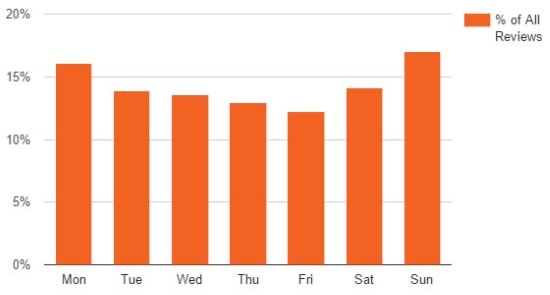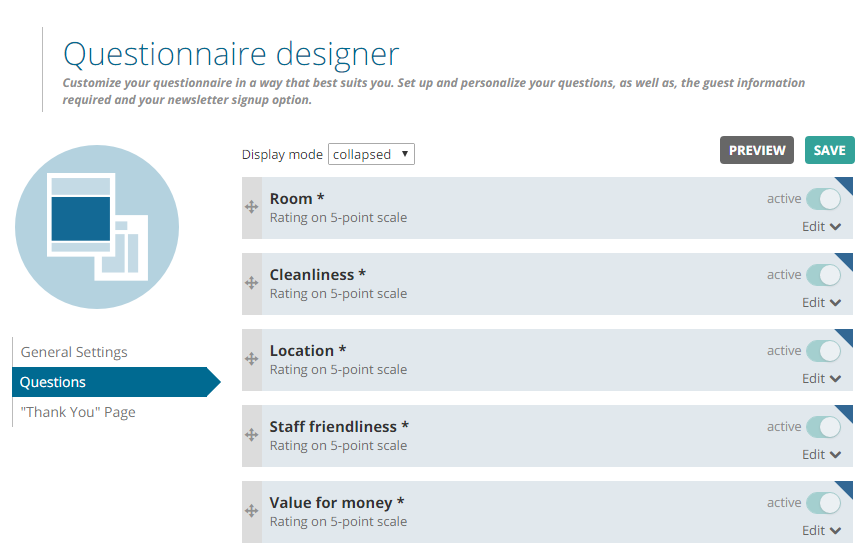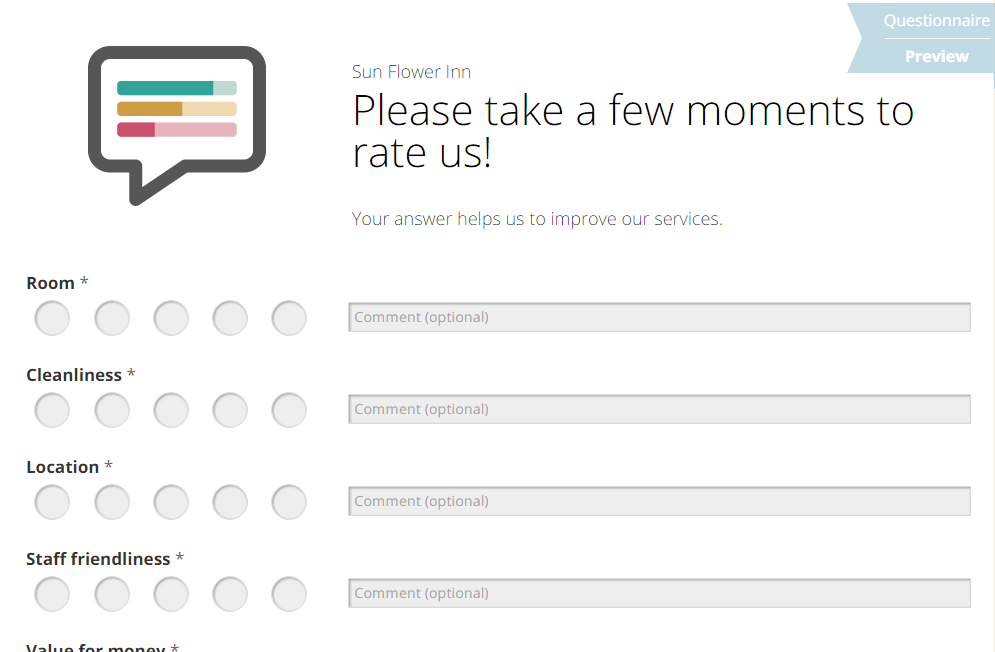
A survey by the customer experience platform Zendesk, found that US consumers are invited to complete surveys 7 billion times a year (that’s almost one survey invite per person on Earth). Maintaining presence in such a survey-saturated market means thinking carefully about how you survey your guests, the kinds of questions you ask, the answers and insights you want to get, and what you can do with such highly sought-after data. In this article we’ll look at how to acquire completed guest satisfaction surveys and tips on how to create your own guest feedback form.
According to a survey by Software Advice, 35% of guests are equally likely to leave feedback at reception during checkout as they are to leave it online a few days later. The preferred methods of feedback are online (41%) and paper forms (32%).
The survey distinguishes between online and via tablet at checkout, with only 22% preferring the latter. It’s clear then that guests do prefer the digital method over the traditional and that they would rather complete an online survey after they have left the hotel rather than via tablet during checkout. Drilling down further, tnooz reports that Sunday and Monday represent the optimal days for receiving guest feedback with over 15% of reviews submitted at the end and beginning of the week. Have a quick look on which day you receive the most guest feedback and, if there’s a pattern, try and send your survey request a couple of days before (giving your guests time to complete the survey).

Interestingly, the Software Advice survey also found that women were more likely to complete guest satisfaction surveys at 59%, compared to men at 41%. It comes as no surprise that it’s the most satisfied and unsatisfied guests who are most likely to let you know their opinions, with 39% of highly satisfied guests and 40% of unsatisfied guests leaving feedback.
Another thing to consider is asking for feedback at different points of the customer journey. See How can I get to know my guests’ opinion during all the phases of their stay?
We’ve looked at why guest satisfaction surveys are important and how you can go about getting them. Now we’re going to look at how to go about creating a guest satisfaction survey and the kinds of questions you might want to include.
Make sure your guest satisfaction survey is bespoke to your business. Remember, distributing reviews increases the potential for more traffic to your website and more direct bookings; so, encouraging guests to review unique and attractive features of your hotel will pique the interest of future guests.

Customer Alliance allows you to tailor your guest satisfaction survey to the interests of your hotel and branding requirements.
As well as tailoring your survey or questionnaire to the needs of your business, keep in mind that it’s your guests completing them. Consider these guest feedback statistics from Zendesk before you start creating a survey:
Try surveying your survey; yes, this sounds a little strange, but it’s a good idea to ask around each department of your hotel (from senior managers to new starters) what information they need to better meet the expectations of your guests.
Also, ask your team members to complete the guest satisfaction survey themselves to see how long it takes. Doing this will help highlights any redundant or awkwardly phrased questions.
Take the stress out of review and customer feedback management. Find out how with one of our experts.
Before creating questions for your guest feedback form, these are some basics you should keep in mind:
To help you gain valuable guest feedback, here are some suggested questions and the reasons for including them:
Asking this helps you identify what’s driving demand. Did the majority (or the minority) of your guests find you through social media, an OTA, or through word-of-mouth? Armed with this data you can make decisions on which channels are working for you and which you should abandon or adjust.
Asking about referral gives an insight into your Net Promoter Score (NPS). Your NPS is a signal of how likely your guests are to positively evangelize for your brand. Net Promoter System suggests a quick way of calculating your NPS:
% of promoters (those who rated you 4 – 5 stars) minus % of detractors (those who rated you 0-3 stars)
Once you’ve calculated your NPS from your guest satisfaction survey, compare it against competitors in your industry. NP Benchmarks give an example NPS for the travel and hospitality industry from a sample of 32 companies across Europe, the US and Asia. The NPS for this sample was 51.3 – how does your hotel compare?
If you’ve been considering additions to your hotel, why not ask guests what they think would improve their experience? You might think that a swimming pool or other costly additions are what your guests are looking for, but from completed surveys it might be something as simple – and affordable – as a more extensive wine selection or softer pillows! Factor in responses to this question when considering major purchases, additions, and renovations.
Of course, the easiest way of ensuring guests complete your questionnaire is to digitize the process. As well as offering the option to customise guest surveys, you should look for customer survey software with an analytics option. You’ll want to create reports from your data to see trends, areas of success, and improvement. Customer survey software should be intuitive, meaning a range of team members are able to use the tool effectively.

Just as important is offering your guests a seamless user experience, which means creating clear and easy-to-use surveys that can be viewed and completed on their mobile or tablet. Here’s an example of our guest satisfaction survey, note the clean and straightforward design. You should make your guest feedback form as easy as possible to complete, reducing the chances of guest’s abandoning the process.

As part of our solution, guests receive your questionnaire after their departure (i.e. within the all-important ‘few days’ period). The conversion rate for our questionnaire is currently at 25%, netting not just the very satisfied and very unsatisfied, but also the precious ‘silent masses.’ Understanding the importance of a guest feedback form, the questionnaire comes in 16 languages and its content and visual design can be tailored to match your own branding. See our article How your business benefits from private feedback for more info on collecting private feedback.
In conclusion, don’t underestimate the benefits of a successful guest satisfaction survey. Take the time to consult with your team before including them into your reputation management process. Additionally, make acquiring and analyzing guest feedback more efficient by investing in an online reputation management system. The value in surveying your guests is limitless, take advantage of it now by requesting a free demo.
Hotels often have systems in place to analyze feedback from guest satisfaction surveys, identifying common issues and areas for improvement. This analysis helps in prioritizing changes that have the potential to significantly enhance guest experiences. Follow-up actions typically involve staff training, service enhancements, or facility upgrades, with progress monitored through subsequent feedback and internal assessments.
Increasing response rates for guest satisfaction surveys can involve several strategies such as personalizing the survey invitation, offering incentives for completion, optimizing the timing of the survey dispatch (often shortly after the stay), and ensuring the survey is mobile-friendly and concise to encourage participation.
Balancing the need for comprehensive feedback with the desire to keep surveys short involves carefully designing questions that are both targeted and broad enough to gather useful information. Techniques include using a mix of open-ended and closed-ended questions, employing a logical flow that makes the survey engaging, and using technology to personalize questions based on the guest’s experience, thereby reducing the number of irrelevant questions and minimizing survey fatigue.